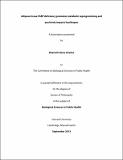| dc.contributor.advisor | Hotamisligil, Gokhan S. | |
| dc.contributor.author | Charles, Khanichi Nona | |
| dc.date.accessioned | 2014-02-25T17:53:22Z | |
| dash.embargo.terms | 2016-02-04 | en_US |
| dash.embargo.terms | 2016-02-04 | |
| dc.date.issued | 2014-02-25 | |
| dc.date.submitted | 2014 | |
| dc.identifier.citation | Charles, Khanichi Nona. 2014. Adipose tissue FABP deficiency promotes metabolic reprogramming and positively impacts healthspan. Doctoral dissertation, Harvard University. | en_US |
| dc.identifier.other | http://dissertations.umi.com/gsas.harvard:11254 | en |
| dc.identifier.uri | http://nrs.harvard.edu/urn-3:HUL.InstRepos:11744425 | |
| dc.description.abstract | The adipose tissue lipid chaperones aP2 and mal1, also known as fatty acid binding proteins (FABPs), are significant molecules contributing to metabolic homeostasis, whereby their absence promotes physiological changes that improve systemic metabolism. Identification of palmitoleate as a lipokine generated in aP2-mal1 deficiency--originating from adipose and directing the lipogenic program in liver, established a role for these chaperones in linking adipocyte and hepatic function. We have recently demonstrated a functional role for secreted aP2 in the activation of gluconeogenesis and hepatic glucose output, further designating this molecule as an adipocyte-derived regulatory factor that influences liver metabolism. Key molecules linking the metabolism of nutrients in energy generating pathways are the nucleotide cofactors NAD and NADH. Together, these molecules function to coordinate the maintenance of redox reactions during normal cellular metabolism and act as required substrates for enzymes such as sirtuins and poly ADP-ribose polymerases. Using global metabolite profiling, we show that combined deficiency of the adipose tissue lipid chaperones aP2 and mal1 leads to a hepatic nucleotide imbalance resulting from metabolic reprogramming in liver. We demonstrate that this reprogramming of metabolite flux is accompanied by significant alterations in liver NAD metabolism and establish a role for aP2 in directing substrate utilization through inhibition of the rate-limiting enzyme for NAD synthesis, nicotinamide phosphoribosyltransferase. Several models for the proposed regulatory pathways that link nutrient metabolism to aging include mechanisms that are NAD dependent. Accordingly, we found that long-term FABP deficiency confers a strong resistance to aging related metabolic deterioration. Together, the findings presented in this thesis support a considerable role for FABPs in the regulation of NAD metabolism and healthspan. | en_US |
| dc.language.iso | en_US | en_US |
| dash.license | LAA | |
| dc.subject | Molecular biology | en_US |
| dc.subject | Aging | en_US |
| dc.subject | Aging | en_US |
| dc.subject | aP2 | en_US |
| dc.subject | FABPs | en_US |
| dc.subject | NAD metabolism | en_US |
| dc.subject | Obesity | en_US |
| dc.subject | Type 2 diabetes | en_US |
| dc.title | Adipose tissue FABP deficiency promotes metabolic reprogramming and positively impacts healthspan | en_US |
| dc.type | Thesis or Dissertation | en_US |
| dash.depositing.author | Charles, Khanichi Nona | |
| dc.date.available | 2016-02-04T08:30:52Z | |
| thesis.degree.date | 2014 | en_US |
| thesis.degree.discipline | Biological Sciences in Public Health | en_US |
| thesis.degree.grantor | Harvard University | en_US |
| thesis.degree.level | doctoral | en_US |
| thesis.degree.name | Ph.D. | en_US |
| dc.contributor.committeeMember | Wessling-Resnick, Marianne | en_US |
| dc.contributor.committeeMember | Yuan, Zhi-Min | en_US |
| dc.contributor.committeeMember | Mair, William | en_US |
| dc.contributor.committeeMember | Puigserver, Pere | en_US |
| dash.contributor.affiliated | Charles, Khanichi Nona | |


